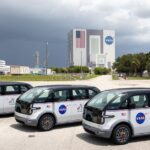After years of rumors and hype, Tesla has finally unveiled its plans for the future of autonomous driving in the form of the new Tesla Cybercab. The Cybercab is the company’s end goal for self-driving tech, essentially serving as a vehicle that’s completely autonomous to the point that it doesn’t even have a steering wheel. The car was finally shown off at Tesla’s “We, Robot” event on October 10 and gives a look at what Tesla thinks is the future of transportation.
At the event, Tesla CEO Elon Musk gave us a ton of details about the vehicle itself and what Tesla hopes to achieve with it. There’s still plenty we don’t know about the Tesla Cybercab, but here’s a look at everything that we do know.
Exterior design
The design of the vehicle is perhaps less surprising than you might assume. It looks kind of like a crossover between the Cybertruck and the Model 3, offering long light bars on the front and rear and a futuristic overall look, but in the shape of something that at least kind of resembles a typical car. Like the Model 3 and Model Y, it has a curved roofline along the top, but unlike those cars, it terminates in a flat rear similar to that of the cismCybertruck.
Perhaps one of the most interesting things about the design is how the wheels look. The wheels of the Cybercab appear to be large, with very slim tires. However, as some event attendees have pointed out, in reality, Tesla simply painted parts of the tires to give them a slimmer style.
Of course, there’s nothing to suggest that the design of the Cybercab can’t change. In fact, aspects of its design are very likely to change between now and its potential release. Tesla vehicles have often changed in design in minor ways between announcement and release. However, for the most part, it’s likely that the vehicle will end up looking at least similar to what the company showed off at its event.

The doors of the Cybercab are interesting too. Instead of opening out like typical car doors, they open up. This not only looks cool, but also means that there’s a little more space for passengers to get into the vehicle. Like the Cybertruck, the Cybercab has a metallic look to it — however unlike the Cybertruck, the color appears to be a kind of light gold.
Interior
Even more interesting than the exterior design of the Tesla Cybercab is what it looks like on the inside. Because the Cybercab is built entirely for autonomous driving, Tesla has room to play around with the interior in more ways than it would otherwise be able to.

There are some obvious changes. For starters, there’s no steering wheel or pedals to be found. The lack of need to drive the vehicle also means that Tesla can push the seats back more, giving the passengers more legroom. The Cybercab that Tesla showed off only has space for two people, and there’s no second row of seating at all.
Other aspects of the design are to be expected. For example, the vehicle has a big 20.5-inch center display that’s built to allow passengers to do things like watch movies and TV shows, play games, and so on.
Range and charging
The fact that the Tesla Cybercab is self-driving means that range isn’t necessarily as much of an issue compared to other electric vehicles. This is because when you’re not driving it, the Cybercab can simply drive itself to a charging station and charge up for when that range is needed. Of course, range will still come into play if you plan on using your vehicle for road trips, for example. Unfortunately, Tesla didn’t really give any details about the range of the Cybercab, but we’re hoping it’ll have a range of at least 300 miles, if not much more.

Perhaps much more interesting than the range of the vehicle is how it charges. According to Musk, the Cybercab won’t have a charging port. but will instead charge through inductive charging — yep, wireless charging just like a smartphone. It’s unclear exactly how this will work and how fast it’ll be able to charge through inductive charging, though.
Basically, the point is that you won’t be able to charge the Tesla Cybercab at a Tesla Supercharger, at least not unless Tesla completely revamps Superchargers for the new car. It’s also unclear if Tesla hopes to eventually move all of its vehicles over to inductive charging, which would be an interesting decision given the fact that the electric vehicle industry is finally moving toward standardization in the U.S., and with a port that Tesla created, no less.
Price and availability
According to Musk, the Cybercab will be on the road by the end of 2027 and will come in at under $30,000. Yes, that means it will be for sale — and not just exist as part of a massive fleet of self-driving taxis that can be used on a per-use basis.
However, Tesla has a pretty poor track record when it comes to accurately predicting pricing and release dates for its vehicles. We still have yet to see the second-generation Tesla Roadster that was first announced in 2017, and the Cybertruck was over two years late, and is currently more than double the price it was announced at in late 2019. In other words, take Tesla’s pricing and release date predictions with a large dos of skepticism — especially given the nature of the vehicle and the fact that it’s entirely possible it won’t even be allowed on roads without ways for a driver to take control.
Read the full article here














